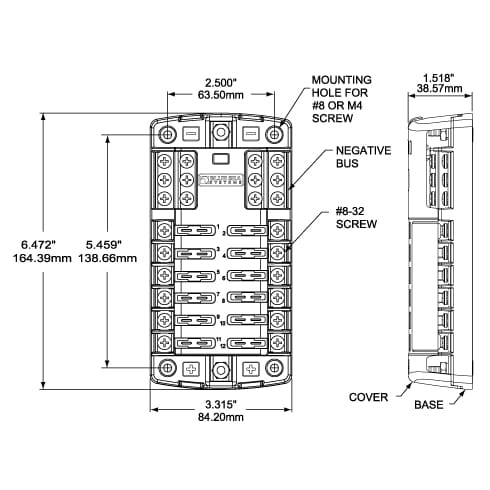Not known Details About Blue Sea Fuse Block
Wiki Article
A Biased View of Blue Sea Fuse Block
Table of ContentsThe Greatest Guide To Blue Sea Fuse BlockNot known Incorrect Statements About Blue Sea Fuse Block Blue Sea Fuse Block - TruthsRumored Buzz on Blue Sea Fuse BlockThings about Blue Sea Fuse BlockBlue Sea Fuse Block - Questions
Fuses are bolted in location between the bus bar as well as the second collection of electrically isolated screws. With this setup you can affix the boat's numerous high-current circuits, such as a windlass, bow thruster, high-output alternator, the DC panel, and so on, to the isolated screws. The different fuses are sized according to the current-carrying ability of the conductors bolted to them.Some circuits will still need to bypass the seclusion switch so that they may be left on when the remainder of the boat is closed down. blue sea fuse block. These circuits usually include a bilge pump and also any charging tools (including solar panels, maybe a wind generator, as well as the inverter if it also functions as a battery charger).
This belongs to the circuit diagram we established for the facility instance watercraft in our Boat Electrics training course. The gadgets attached to the fuse block in the upper right are all bypassing the isolation switch S1. If you enroll in Watercraft Electrics 101, you will certainly learn exactly how to check out such a diagram as well as also how to make one for your own boat.
Blue Sea Fuse Block Can Be Fun For Anyone

The goal is to offer defense at the resource of power for each circuit. With DC circuits, the OCP is constantly positioned in the silver lining of DC circuits. (In addition to anything else, an unbroken connection to DC unfavorable have to be maintained in any way times to shield against stray-current corrosion.) Note that some European boatbuilders set up integrates and battery switches in the DC unfavorable side as well as on the silver lining, but this is not recommended except in some isolated (floating) ground DC systems.
This factor may be at the battery, the battery button, the circulation panel, a subsidiary panel, some circulation bus bar, or other attaching factor. If the conductors in the new circuit are no smaller sized than the conductor that feeds the new circuit's factor of connection, after that the OCP for the feeder conductor will completely secure the new circuit - blue sea fuse block.
All About Blue Sea Fuse Block
However if the brand-new circuit is not appropriately served by overcurrent gadgets currently in location, added security is needed at its factor of connection, i. Get More Info e., at its source of power. Positioning of merges in the favorable conductor. Keep in mind how a smaller fuse is utilized every time a smaller sized conductor is connected, Often room restricts just how close an OCP device can be put to the source of power.The generic solution, from the ABYC, is within 7" (17. The ABYC permits the adhering to, which have actually been tightened up in recent years: A conductor connected directly to a battery that is additionally "had throughout its whole range in a sheath or room such as a channel, junction box, control box or encased panel" have to have its overcurrent defense "as close as possible to the battery, but not to exceed 72 inches (1.
Gone is the covering 72" allocation that utilized to be there. A conductor connected to a resource of power aside from the battery (e. g., the battery switch, the circulation panel, or a few other point in the DC circuits) that is similarly had in a sheath, and so on, should have its overcurrent protection "as close as achievable to the point of link to the source of power, but not to surpass 40 inches (1.
The Buzz on Blue Sea Fuse Block
Offered that generators themselves are a source of power, it has actually been debatable whether these added alternators needed OCP at the generator itself."Cranking-motor circuits are not called for to have overcurrent defense.In the aquatic area, where cranking circuits may be long, this method may produce a threat. It makes no feeling to have any kind of unprotected circuits on a boat.
In winter, the inrush current on a 12V starter electric motor might be as high as 1,500 amps; the cranking sites current may be as long as 200 amps. Often, cranking conductors are undersized even for the cranking existing, allow alone the inrush present. This scenario does not posture a safety and security issue per se, because these currents are sustained for just a couple of secs, so the conductors do not have time to fume adequate to produce a fire risk.
The Facts About Blue Sea Fuse Block Uncovered
We made the course with absolute newbies in mind. As the electrical tons on watercrafts rises, so as well does the intricacy of electric circuits as well as the possibility for brief circuits as well as electric fires.
In the aquatic field, where cranking circuits might be long, this practice may create a threat. If a cars and truck catches fire, the owners can pull over and also jump out. If a watercraft ignites, it is not so basic. It makes no feeling to have any type of unsafe circuits on a boat.
Some Known Factual Statements About Blue Sea Fuse Block

We made the training course with absolute novices in mind. As the electric lots on boats increases, so as well does the intricacy of electric circuits and also the capacity for brief circuits and also electrical fires.
Report this wiki page